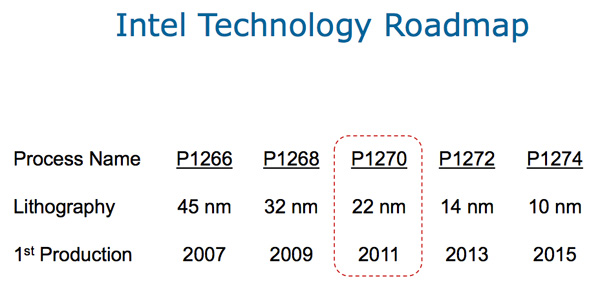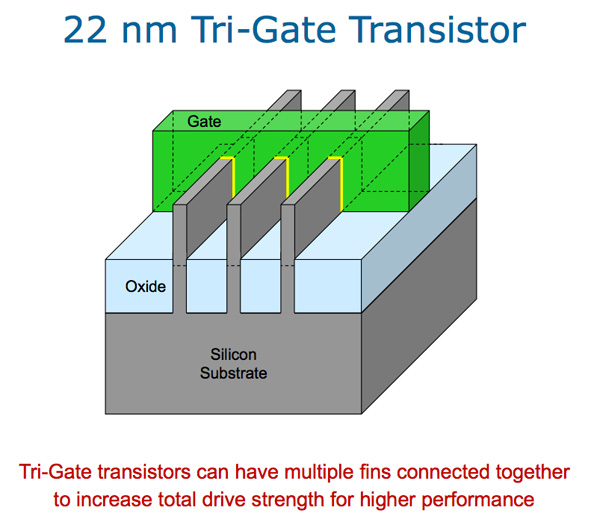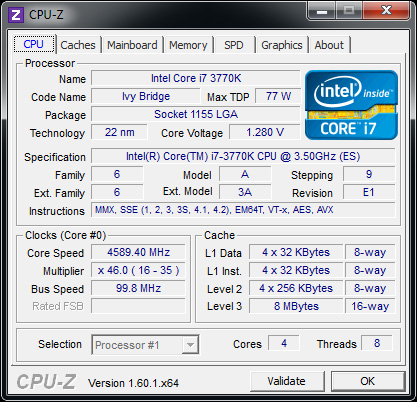The Intel Ivy Bridge (Core i7 3770K) Review
by Anand Lal Shimpi & Ryan Smith on April 23, 2012 12:03 PM EST- Posted in
- CPUs
- Intel
- Ivy Bridge
Overclocking and 22nm
In the old days, whenever Intel transitioned to a new manufacturing process it was accompanied by increased overclocking headroom thanks to the reduction in power consumption and increase in switching speed afforded by the new transistors. To be honest, it's surprising the ride has even lasted this long.

Intel's 22nm process (P1270) is the most ambitious yet. The non-planar "3D" transistors promise to bring a tremendous increase in power efficiency by increasing the surface area of the transistor's inversion layer. It's the vehicle that will bring Intel into new form factors in mobile, but we're around a year away from Haswell's introduction. Rather than 22nm being a delivery platform for Ivy Bridge, it feels like Ivy Bridge is being used to deliver 22nm.

The process is still young and likely biased a bit towards the lower leakage characteristics of lower voltage/lower wattage CPUs, such as those that would be used in Ultrabooks. These two factors combined with some architectural decisions focused on increasing power efficiency result in what many of you may have heard by now: Ivy Bridge won't typically overclock as high as Sandy Bridge on air.
The frequency delta isn't huge. You'll still be able to hit 4.4—4.6GHz without resorting to exotic cooling, but success in the 4.8—5.0GHz range will be limited to water alone for most. Ivy Bridge is also far more sensitive to voltage than Sandy Bridge. Heat dissipation can increase significantly as a function of voltage, so you'll want to stay below 1.3V in your overclocking attempts.
Dr. Ian Cutress, our own Senior Motherboard Editor, put Ivy Bridge through a pretty exhaustive investigation if you want more details on exactly how the chip behaves when overclocking and how best to overclock it.
For the past few years I've been focused on power efficient overclocking. I'm looking for the best gains I can get without significant increases in core voltage. With my 3770K I was able to reliably hit 4.5GHz with only a 140mV increase in core voltage:

The end result is a 15—28% overclock, accompanied by a 32% increase in power consumption. The relationship between overclock speed and power consumption actually hasn't changed since Ivy Bridge, at least based on this datapoint.
| Ivy Bridge Overclocking | |||||
| Intel Core i7 3770K | Stock | 4.6GHz Overclock | % Increase | ||
| Load Power Consumption | 146.4W | 204W | 39.3% | ||
| x264—2nd Pass | 41.8 fps | 49.5 fps | 18.4% | ||
As always, your mileage may vary depending on the particular characteristics of your chip. Ivy Bridge can be overclocked, but at least initially it's not going to be as good of an overclocker as Sandy Bridge. Over time I expect this to improve somewhat as Intel's 22nm process matures, but by how much remains a question to me. It's unclear just how much of these limits are by design vs. a simple matter of process maturity.











173 Comments
View All Comments
dagamer34 - Monday, April 23, 2012 - link
I see them just killing off the 13" MacBook Pro entirely, and upgrading the SSD base size to 256GB. There's little reason for the Pro to live on anymore when the Air is far superior in everything except for CPU.gorash - Monday, April 23, 2012 - link
Really... the Air's screen is terrible. Plus Air is basically not user upgradeable.Breach1337 - Monday, April 23, 2012 - link
Yeah, I view mine as a consumable. And I love it.tipoo - Monday, April 23, 2012 - link
That would be a shame, even without the optical drive they could differentiate the 13" pro from the Air with the mentioned 35w quad core CPU, or a discreet GPU in all the space they saved from ditching the ODD, and have more space for battery to offset it.jaydee - Monday, April 23, 2012 - link
If I'm buying a system for onboard GPU gaming, I'm going AMD. If I'm buying a system for cpu performance with overclocking, I'm buying Sandy Bridge. I'm not sure what the point of this launch is.A5 - Monday, April 23, 2012 - link
Notebooks/ultrabooks and debugging the new process node.8steve8 - Monday, April 23, 2012 - link
I've seen so many negative comments like this about Ivy Bridge all over the web... so I'll respond to them all here:I'd rather have higher energy efficiency and stability (and less noise), which comes with running at stock voltage/clock speeds. I am not alone there... Plus with turbo boost, why bother OCing, when it has the thermal headroom, it boosts the clock...
If you think that you can find a significantly better sweat spot of performance, power consumption, and reliability/lifespan of the average high-end (K) CPU from intel, then I have to call BS on that. If you agree that intel knows their cpus better than you, but are purposely under-clocking them (the highest clocked models), then I would ask why.
I may say that given significantly more exotic/larger/louder coolers, maybe you can dissipate more heat than the processors were designed to dissipate, and you have some headroom to raise the voltage, which may yield higher stable frequencies, but keep in mind power is roughly proportional to voltage^2, so energy efficiency goes out the window real fast...
I'm not saying no one should play around with their CPUs, have fun... but to say ivy bridge is pointless just because you can't over-volt/over-clock it to the same extent as sandy bridge is foolish when it's clearly a significant step forward, and the best solution for the vast majority x86 PCs.
For those of us who want an energy efficient, high performance computer, some variant of ivy bridge will be the best option, probably until haswell/2013.
Thanks intel, and thanks Anand for the review.
jaydee - Monday, April 23, 2012 - link
But it's really not that much more efficient. In fact at idle, the difference is negligible by all benchmarks I've seen, which for most users is the most important area. At full power, a difference of 25 watts is practically nothing given how much time most cpu's are spent at that load. It really shouldn't affect power supply sizing either. I'm just talking about desktop usage here, we don't really have a good look at the notebook chips yet.I'm not sure what Intel thinks it's pulling by calling this "tick+" instead of a regular "tick". I don't see anything here that's really that appealing. If helps Intel "debug the process node for 22nm", that's great for Intel, but it doesn't sway me as a consumer to buy one.
JarredWalton - Monday, April 23, 2012 - link
Idle power quickly hits a limit based on everything else in the system. It's hardly surprising that the highly efficient Sandy Bridge does just as well at idle as Ivy Bridge. Power gating allows Intel to basically shut down everything that's not being used, and the result is that low loads have pretty much hit their limits. What's impressive is the big drop in power use under heavier loads.As for the "tick+", it's all in the GPU. They went from DX10 12EU in SNB to DX11 and 16EU in IVB. As a percentage of total die size, the GPU in IVB is much larger than the one in SNB. But as Anand notes, we still would have liked more (e.g. a 24 EU GT3 would have been awesome for IGP performance).
owan - Monday, April 23, 2012 - link
Marginal improvement over Sandy Bridge that can be compensated for by SB's significantly better overclocking ability. Why so much praise for the IGP when 95% of desktop users don't care AND its still vastly inferior to Llano? With so much focus on mobile I'm not even sure why they bothered releasing a high-end desktop SKU